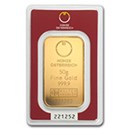
Gold from the Austrian Mint
The Austrian Mint, also known as Münze Österreich AG, is one of the oldest mints in Europe and is located in Vienna, Austria. The mint produces a variety of precious metal products, including gold coins and bars.
One of the most well-known gold products from the Austrian Mint is the Vienna Philharmonic gold coin. This coin was first introduced in 1989 and has become one of the most popular gold coins in the world. The design features the famous Vienna Philharmonic orchestra, and the reverse side shows various musical instruments, including a horn, bassoon, harp, and cello.
The Vienna Philharmonic gold coin is available in several different weights, including 1/25 oz, 1/10 oz, 1/4 oz, 1/2 oz, and 1 oz. The coins are made from 99.99% pure gold and are legal tender in Austria with a face value denominated in euros.
In addition to the Vienna Philharmonic gold coin, the Austrian Mint also produces a variety of gold bars in different sizes, ranging from 1 gram to 1 kilogram. These bars are also made from 99.99% pure gold and feature the Austrian Mint's logo.
Overall, the Austrian Mint is a reputable and well-respected mint that produces high-quality gold products that are popular among investors and collectors around the world.
Discerning investors looking to compare larger gold bar sizes from different mints may want to explore our collection of 1 kg gold bars.History of the Austrian Mint
The Austrian Mint has a long and rich history that dates back to the Middle Ages. The mint was first established in Vienna in 1194 by Duke Leopold V of Austria. At the time, the mint produced mainly silver coins, which were used as currency throughout the region.
Over the centuries, the mint continued to produce coins and other precious metal products for the Austrian Empire, which included much of central and eastern Europe. In the 16th century, the mint began producing gold coins, which were highly valued for their purity and quality.
In the late 19th and early 20th centuries, the Austrian Mint became known for producing some of the world's most beautiful and intricate coins. One of the most famous examples is the Austrian gold ducat, which features an image of Saint Michael slaying a dragon.
During World War I and World War II, the Austrian Mint was heavily damaged, but it was rebuilt and continued to produce coins and other products in the post-war era. In 1989, the mint introduced the Vienna Philharmonic gold coin, which quickly became one of the world's most popular gold coins.
Today, the Austrian Mint is a modern and innovative mint that produces a wide range of precious metal products for collectors and investors around the world. Despite its long history, the mint continues to be at the forefront of the industry, using the latest technology and techniques to produce high-quality products.
The Austrian Mint’s Facility
The Austrian Mint facility is located in the heart of Vienna, Austria, and has a rich and fascinating history that spans over eight centuries. The facility was first established in 1194 by Duke Leopold V of Austria, who saw the need for a mint to produce currency for his expanding realm. The original mint was located in the Babenberger palace, which was destroyed by fire in the 15th century.
In the 16th century, the mint was moved to a new location in the Vienna Hofburg palace, where it remained until the late 19th century. During this time, the mint produced some of the world's most beautiful and intricate coins, including the gold ducat, which features an image of Saint Michael slaying a dragon.
In the late 19th century, the mint was moved again, this time to a new purpose-built facility in Vienna's 3rd district. The new facility was state-of-the-art for its time and featured the latest technology and equipment for producing coins and other precious metal products.
During World War II, the Austrian Mint was heavily damaged, and its equipment and machinery were looted by the occupying forces. However, the mint was quickly rebuilt after the war and continued to produce coins and other products in the post-war era.
Today, the Austrian Mint facility is a modern and innovative facility that uses the latest technology and techniques to produce high-quality coins and other precious metal products. The mint is renowned for its quality and craftsmanship, and its products are highly sought after by collectors and investors around the world.
Overall, the Austrian Mint operates in a facility that embodies both the history and modern progress of the mint. The time-honored architecture also houses a state-of-the-art production plant where centuries of minting experience combine with internationally renowned proprietary coin crafting technology.
Learn More About Precious Metals
Buying Precious Metals doesn’t have to be intimidating. Whether you are making a long-term investment or simply admire the beauty of Precious Metals, APMEX provides the tools to help you make the best choice for your portfolio.
See All Articles



.png?v=20240126101429&width=130&height=130)







